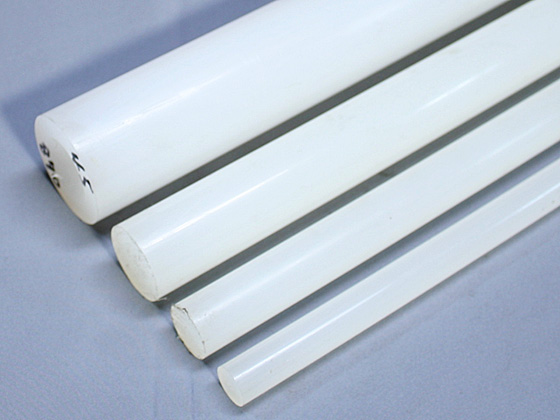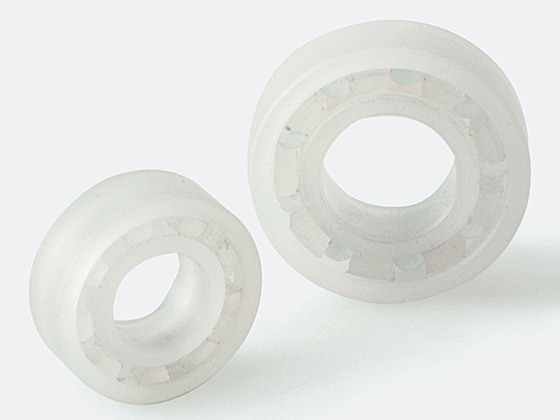 |
 |
These are the properties of PP (Polypropylene), a material used in plastic bearings. Take a look at the characteristics of this material.
Overview of PP
PP stands for Polypropylene, a polymer produced by the polymerization of propylene. It has a low density, floats on water, and is resistant to chemicals. However, it has poor dyeability and only limited heat resistance.
Characteristics of PP
◎Recommended ○Satisfactory △Possible to use, but not recommended ×Not compatible
| Material | Product Code |
Dry | Water (extended periods of time) |
Water |
Steam | Chemical Environment | Magnetic Environment |
As Insulator |
|||
|---|---|---|---|---|---|---|---|---|---|---|---|
| Acids | Alkaline | Organic Liquids |
Oil | ||||||||
| Phenol | SD | ◎ | ◎ | ◎ | ◎ | ○ | × | ◎ | ◎ | ◎ | ◎ |
| SDK | ◎ | ◎ | ◎ | ◎ | ○ | × | ◎ | ◎ | × | × | |
| SDHG | ◎ | △ | △ | × | ○ | × | ○ | ◎ | × | × | |
| PTFE | PT | ◎ | ◎ | ◎ | ◎ | ◎ | ◎ | ◎ | ◎ | ◎ | × |
| PTG | ◎ | ◎ | ◎ | ◎ | ◎ | × | ◎ | ◎ | ◎ | ◎ | |
| PTE | ◎ | ◎ | ◎ | ◎ | ◎ | ◎ | ◎ | ◎ | ◎ | ◎ | |
| PTN | ◎ | ◎ | ◎ | ◎ | ◎ | ◎ | ◎ | ◎ | ◎ | ◎ | |
| UHMW | PE | ○ | ○ | ◎ | × | ◎ | ◎ | ◎ | ◎ | ◎ | ◎ |
| PP | PP | △ | ○ | ○ | △ | ○ | ○ | ○ | ○ | ◎ | ◎ |
| PEEK | PK | ○ | ○ | ○ | ○ | ◎ | ◎ | ◎ | ◎ | ◎ | ◎ |
| PKG | ◎ | ○ | ○ | ◎ | ◎ | ◎ | ◎ | ◎ | ◎ | × | |
| PPS | PS | ○ | ◎ | ◎ | ◎ | ◎ | ◎ | ◎ | ◎ | ◎ | ◎ |
| PSG | ◎ | ◎ | ◎ | ◎ | ◎ | ◎ | ◎ | ◎ | ◎ | × | |
| PCTFE | PCT | ○ | ○ | ○ | ◎ | ◎ | ◎ | ○ | ○ | ◎ | ◎ |
| PVDF | PV | ○ | ○ | ○ | ◎ | ◎ | ◎ | ○ | ○ | ◎ | ◎ |
| Carbon | CY | ◎ | ○ | ○ | ◎ | ◎ | ◎ | ◎ | ◎ | ○ | × |
Note: Please contact us for detailed information regarding compatibility with specific chemicals.
Temperature resistance performance of PP
☆Highly recommended ◎Recommended ○Satisfactory △Possible to use, but not recommended ×Not compatible
| Material | Product Code |
Temperature | |||||||
| -190℃~ | -100℃~ | -50℃~ | -20℃~ | Room or Operating Temperature | ~120℃ | ~200℃ | ~350℃ | ||
| Phenol | SD | × | × | 〇 | ◎ | ☆ | ◎ | × | × |
| SDK | × | × | 〇 | ◎ | ☆ | ◎ | × | × | |
| PTFE | PT | 〇 | ◎ | ◎ | ◎ | ☆ | ◎ | △ | × |
| PTG | 〇 | ◎ | ◎ | ◎ | ☆ | ◎ | △ | × | |
| PTE | 〇 | ◎ | ◎ | ◎ | ☆ | ◎ | △ | × | |
| UHMW | PE | × | △ | 〇 | 〇 | ☆ | × | × | × |
| PP | PP | × | △ | 〇 | 〇 | ☆ | 〇 | × | × |
| PEEK | PK | × | × | 〇 | ◎ | ☆ | ◎ | 〇 | × |
| PKG | × | × | 〇 | ◎ | ☆ | ◎ | ◎ | × | |
| PPS | PS | × | × | × | 〇 | ☆ | ◎ | 〇 | × |
| PSG | × | × | × | 〇 | ☆ | ◎ | 〇 | × | |
| PCTFE | PCT | × | × | 〇 | ◎ | ☆ | 〇 | × | × |
| Carbon | CY | × | × | △ | 〇 | ☆ | ◎ | ◎ | ◎* |
*Note: Please consider the coefficient of thermal expansion, or contact us for specialized applications.

